A New Experimental Setup to Characterize Binder–Vegetal Particle Compatibility in Plant-Based Concrete
Abstract
1. Introduction
2. Method and Equipment
- The impact of the couple binder/vegetal particle of the ITZ size;
- Which of the absorption or the release of vegetal components phenomena is responsible or dominant for the formation of the ITZ.
2.1. Improvement of Existing Protocol
2.2. Production of Fiber Pellet
2.3. Production of Foam Pellet Soaked in Sucrose Solution
2.4. Preparation of Acetate Film
2.5. Preparation of Cement Paste
2.6. Setting the Experiment
2.7. Image Processing and Analysis
3. Parameters
4. Analysis and Discussion
4.1. Compatibility between Vegetal Particles and Binders
4.2. Origin of ITZ
4.3. Impact of the Mass of Vegetal Particles
4.4. Color and Kinetics of the Apparition of the Halo
5. Conclusions and Perspectives
- Vegetal particle and binder compatibility: Among the tested combinations, a hemp shiv mixed with Prompt cement exhibited the best compatibility, marked by a significantly smaller ITZ. This compatibility is crucial to optimizing the mechanical properties of the concrete.
- Formation of ITZ: Our experiments determined that the ITZ is primarily formed not due to water absorption from the cement paste via vegetal particles but through the diffusion of vegetal molecules, particularly free saccharide molecules, into the cement paste. This finding shifts the focus towards understanding and controlling the release of these molecules to improve material performance.
- Influence of sugar concentration and pellet mass: The size of ITZ is linked to the sugar concentration in the vegetal particles and the mass of the vegetal particle pellet. Higher sugar concentrations and pellet masses lead to larger ITZs, suggesting that the control of these factors could be vital for material design.
- Experimental protocols: The refinement of experimental protocols led to more consistent and reliable observations of ITZ, highlighting the importance of meticulous experimental design in materials research.
- Investigating alternative sugars and porosities: Exploring the effects of different sugars found in vegetal particles, such as xylose, and varying foam porosities could provide deeper insights into the mechanisms of ITZ formation.
- Surface interaction studies: Further experiments should focus on the interaction surface between vegetal particles and binders, considering different sizes of pellets to understand the role of physical contact in ITZ formation.
- Long-term analysis of ITZ: Studying the ITZ over longer periods will be crucial to assessing the delayed hydration processes and the eventual reduction in the ITZ size, which could impact the long-term mechanical properties of concrete.
- Mechanical testing: Compressive tests with cubic samples of vegetal concrete are needed to directly correlate ITZ characteristics with the mechanical strength of the materials, validating the effectiveness of the developed test in predicting material performance.
Author Contributions
Funding
Data Availability Statement
Conflicts of Interest
References
- Ministère de la Transition Ecologique et de la Cohésion des Territoires. Réglementation Environnementale RE2020. Available online: www.ecologie.gouv.fr/reglementation-environnementalere2020 (accessed on 1 October 2022).
- Jebli, M.; Jamin, F.; Malachanne, E.; Garcia-Diaz, E.; El Youssoufi, M. Experimental characterization of mechanical properties of the cement-aggregate interface in concrete. Constr. Build. Mater. 2018, 161, 16–25. [Google Scholar] [CrossRef]
- Diquelou, Y. Impact of Hemp Shiv on Cement Setting and Hardening: Influence of the Extracted Components from the Aggregates and Study of the Interfaces with the Inorganic Matrix. Ph.D. Thesis, Université de Reims, Reims, France, 2015. [Google Scholar]
- Delhomme, F.; Prud’homme, E.; Julliot, C.; Guillot, T.; Amziane, S.; Marceau, S. Effect of Hemp on cement hydration: Experimental characterization of the interfacial transition zone. Results Chem. 2022, 4, 100440. [Google Scholar] [CrossRef]
- Magniont, C.; Escadeillas, G. Chemical Composition of Bio-aggregates and Their Interactions with Mineral Binders. In Bio-aggregates Based Building Materials; Amziane, S., Collet, F., Eds.; RILEM State-of-the-Art Reports; Springer: Dordrecht, The Netherlands, 2017; Volume 23. [Google Scholar] [CrossRef]
- Friedemann, K.; Stallmach, F.; Kaerger, J. Carboxylates and sulfates of polysaccharides for controlled internal water release during cement hydration. Cem. Concr. Compos. 2009, 31, 244–249. [Google Scholar] [CrossRef]
- Ghio, V.; Monteiro, P.; Demsetz, L. The rheology of fresh cement paste containing plysaccharide gums. Cem. Concr. Res. 1994, 24, 243–249. [Google Scholar] [CrossRef]
- Lu, Z.Y.; Hux, X.B.; Hou, Y.; Zeng, T.; Tao, X.M. The influence of polyacrylamide, polyether polysaccharide and aminosulfonic acid-based superplasticzer on properties of cement paste. In Proceedings of the 6th International Symposium on Cement & Concrete and CANMET/ACI International Symposium on Concrete Technology for Sustainable Development; Tongbo, S., Rongxi, S., Wensheng, Z., Eds.; Chinese Ceram Society: Beijing, China, 2006; Volumes 1 and 2, pp. 1537–1543. [Google Scholar]
- Peschard, A.; Govin, A.; Fredon, E.; Grosseau, P.; Fantozzi, G. Influence of polysaccharides on cement hydration. In EURO CERAMICS VIII, PTS 1-3, Key Engineering Materials; Mandal, H., Ovecoglu, L., Eds.; Turkish Ceram Society: İstanbul, Turkey; European Ceram Society: Mons, Belgium, 2006; pp. 2141–2144. [Google Scholar] [CrossRef]
- Peschard, A.; Govin, A.; Grosseau, P.; Guilhot, B.; Guyonnet, R. Effect of polysaccharides on the hydration of cement paste at early ages. Cem. Concr. Res. 2004, 34, 2153–2158. [Google Scholar] [CrossRef]
- Peschard, A.; Govin, A.; Pourchez, J.; Fredon, E.; Bertrand, L.; Maximilien, S.; Guilhot, B. Effect of polysaccharides on the hydration of cement suspension. J. Eur. Ceram. Soc. 2006, 26, 1439–1445. [Google Scholar] [CrossRef]
- Zhang, H.; Feng, P.; Li, L.; Wang, W. Effects of starch-type polysaccharide on cement hydration and its mechanism. Thermochim. Acta 2019, 678, 178307. [Google Scholar] [CrossRef]
- Kiminami, K.; Konishi, T.; Mizumoto, M.; Nagata, K.; Honda, M.; Arimura, H.; Aizawa, M. Effects of Adding Polysaccharides and Citric Acid into Sodium Dihydrogen Phosphate Mixing Solution on the Material Properties of Gelatin-Hybridized Calcium-Phosphate Cement. Materials 2017, 10, 941. [Google Scholar] [CrossRef] [PubMed]
- Pooput, K.; Monmaturapoj, N.; Sansatsadeekul, J.; Channasanon, S.; Srion, A. Preparation and characterization of calcium phosphate bone cement with rapidly-generated tubular macroporous structure by incorporation of polysaccharide-based microstrips. Ceram. Int. 2017, 43, 3616–3622. [Google Scholar] [CrossRef]
- Sawamura, T.; Hattori, M.; Okuyama, M.; Kondo, K. Effects of polysaccharides addition in calcium phosphate cement. In Bioceramic, Vol 16, Key Engineering Materials; Barbosa, M., Monteiro, F., Correia, R., Leon, B., Eds.; INEB Instituto Nacional de Engenharia Biomédica: Porto, Portugal, 2004; pp. 209–212. [Google Scholar] [CrossRef]
- Schmidt, W.; Brouwers, H.J.H.; Kuehne, H.-C.; Meng, B. Interactions of polysaccharide stabilising agents with early cement hydration without and in the presence of superplasticizers. Constr. Build. Mater. 2017, 139, 584–593. [Google Scholar] [CrossRef]
- Vieira, M.; Klemm, D.; Einfeldt, L.; Albrecht, G. Dispersing agents for cement based on modified polysaccharides. Cem. Concr. Res. 2005, 35, 883–890. [Google Scholar] [CrossRef]
- Boix, E.; Gineau, E.; Narciso, J.O.; Hofte, H.; Mouille, G.; Navard, P. Influence of chemical treatments of miscanthus stem fragments on polysaccharide release in the presence of cement and on the mechanical properties of bio-based concrete materials. Cem. Concr. Compos. 2020, 105, 103429. [Google Scholar] [CrossRef]
- Diquelou, Y. Influence of Binder Characteristics on the Setting and Hardening of Hemp Lightweight Concrete. Ph.D. Thesis, Université de Reims, Reims, France, 2016. [Google Scholar]
- Martinhao, N. Mechanical and Thermal Properties of Mineral-Vegetal Composites; Polytech Clermont: Ferrant, France, 2022. [Google Scholar]
- Julliot, C. Effect of Hemp on Cement Hydration; PIRD INSA Lyon: Lyon, France, 2021. [Google Scholar]
- NI. LabVIEW: Logiciel de Développement de Systèmes Pour les Applications de Test, de Mesure et de Contrôle/Commande. Available online: https://www.ni.com/en/support/downloads/software-products/download.labview.html#521715 (accessed on 1 October 2022).
- Adobe Inc. Adobe Lightroom Classic 2019 Version 8.4.1. Available online: https://www.adobe.com/products/photoshop-lightroom-classic.html (accessed on 1 October 2022).
- The MathWorks Inc. Matlab 2021 Version 9.11.0.1837725. Available online: https://fr.mathworks.com/products/matlab.html (accessed on 1 October 2022).
- NIH Image. ImageJ Version 1.53. Available online: https://imagej.net/ij/docs/guide/index.html (accessed on 1 October 2022).
- Vyskocilova, R.; Schwarz, W.; Mucha, D.; Hughes, D.; Kozłowski, R.; Weber, J. Hydration Processes in Pastes of Roman and American Natural Cements. J. ASTM Int. 2007, 4, 1–10. [Google Scholar] [CrossRef]
- Cokely, A.L.B. Influence de la nature biochimique et physicochimique de végétaux sur les mécanismes d’hydratation des matériaux cimentaires. In MEMOIRE DE STAGE DE MASTER 2e ANNEE; Marceau, S., Ed.; University Gustave Eiffel: Marne-la-vallée, France, 2022; pp. 18–19. [Google Scholar]


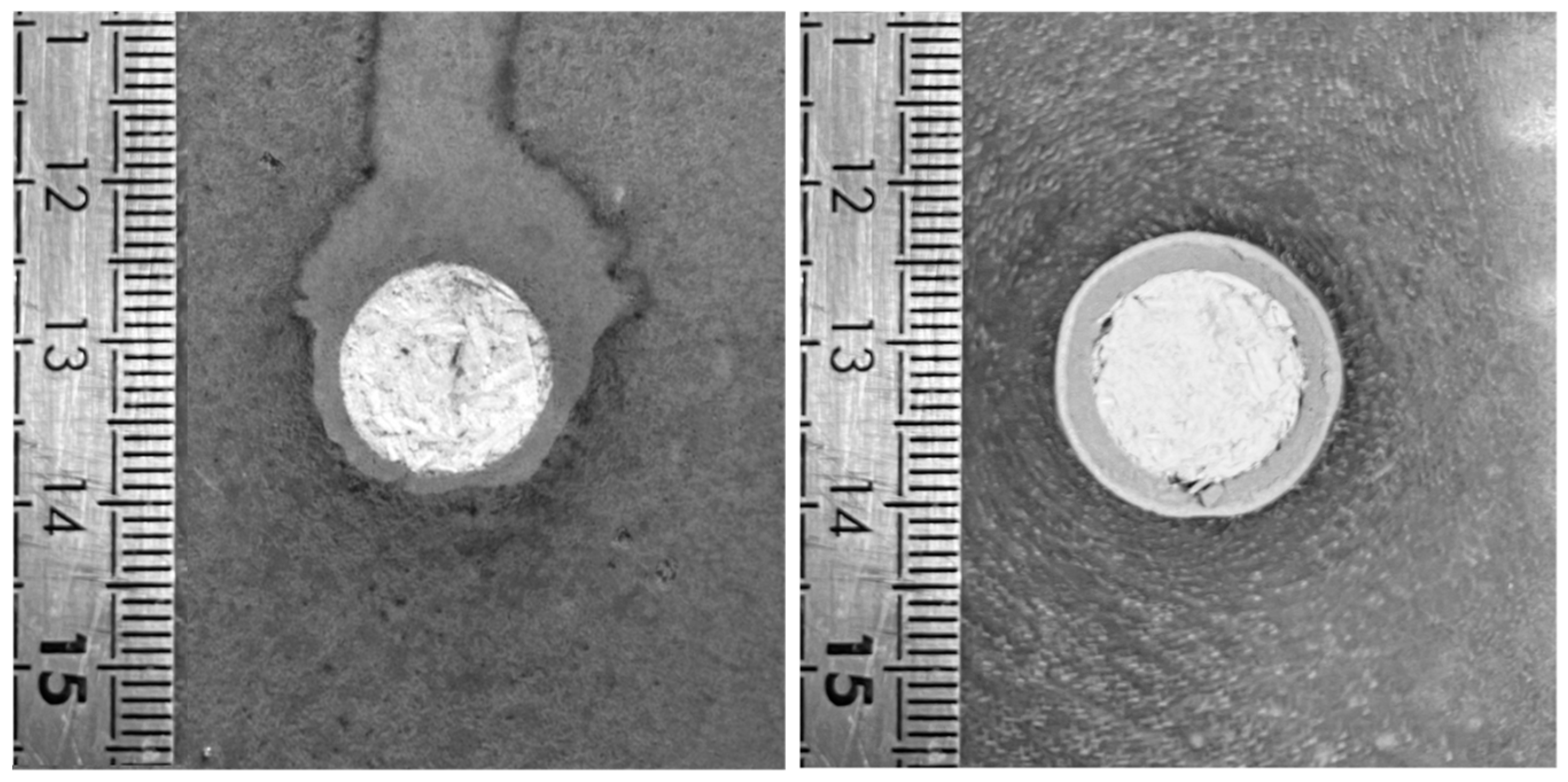
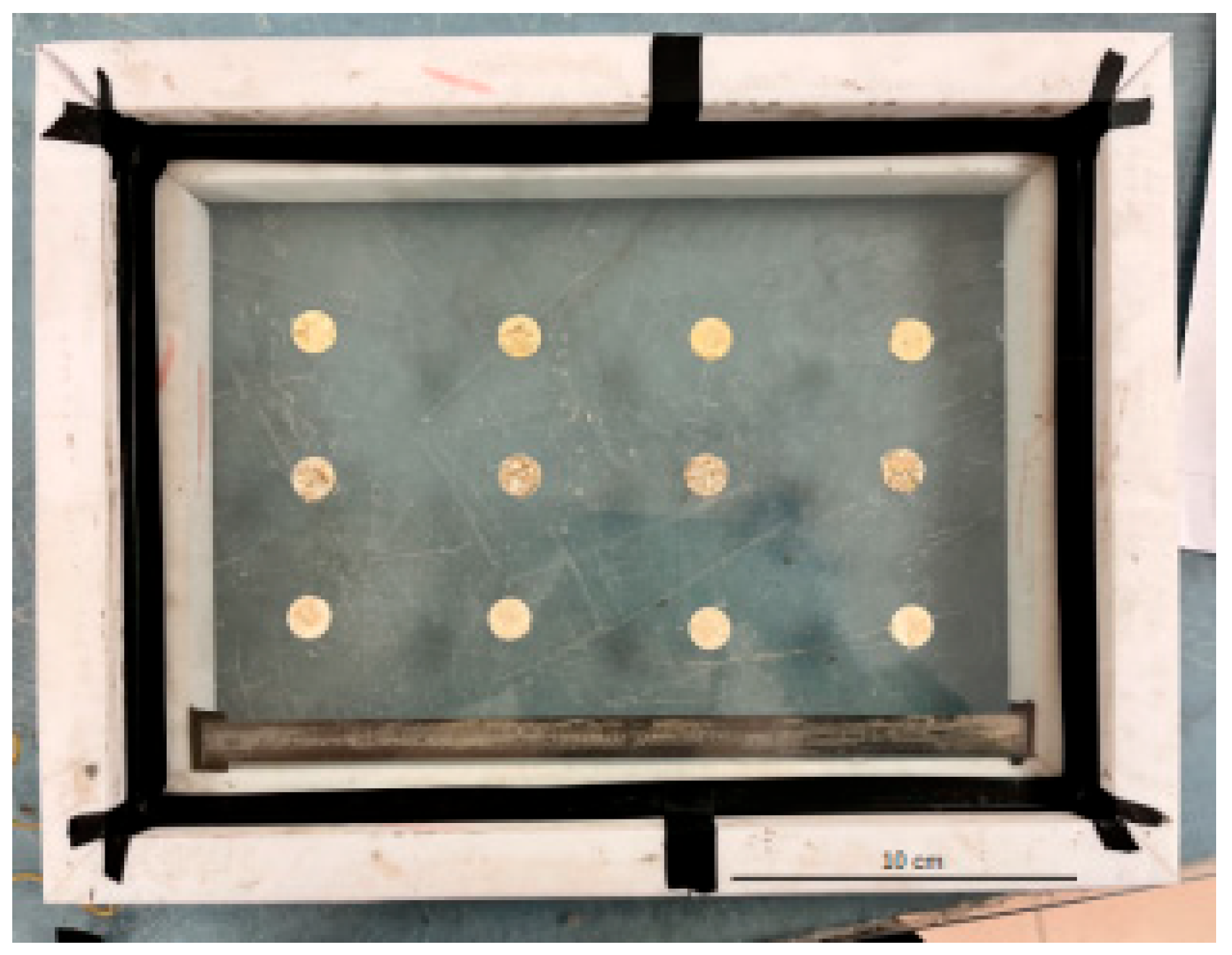

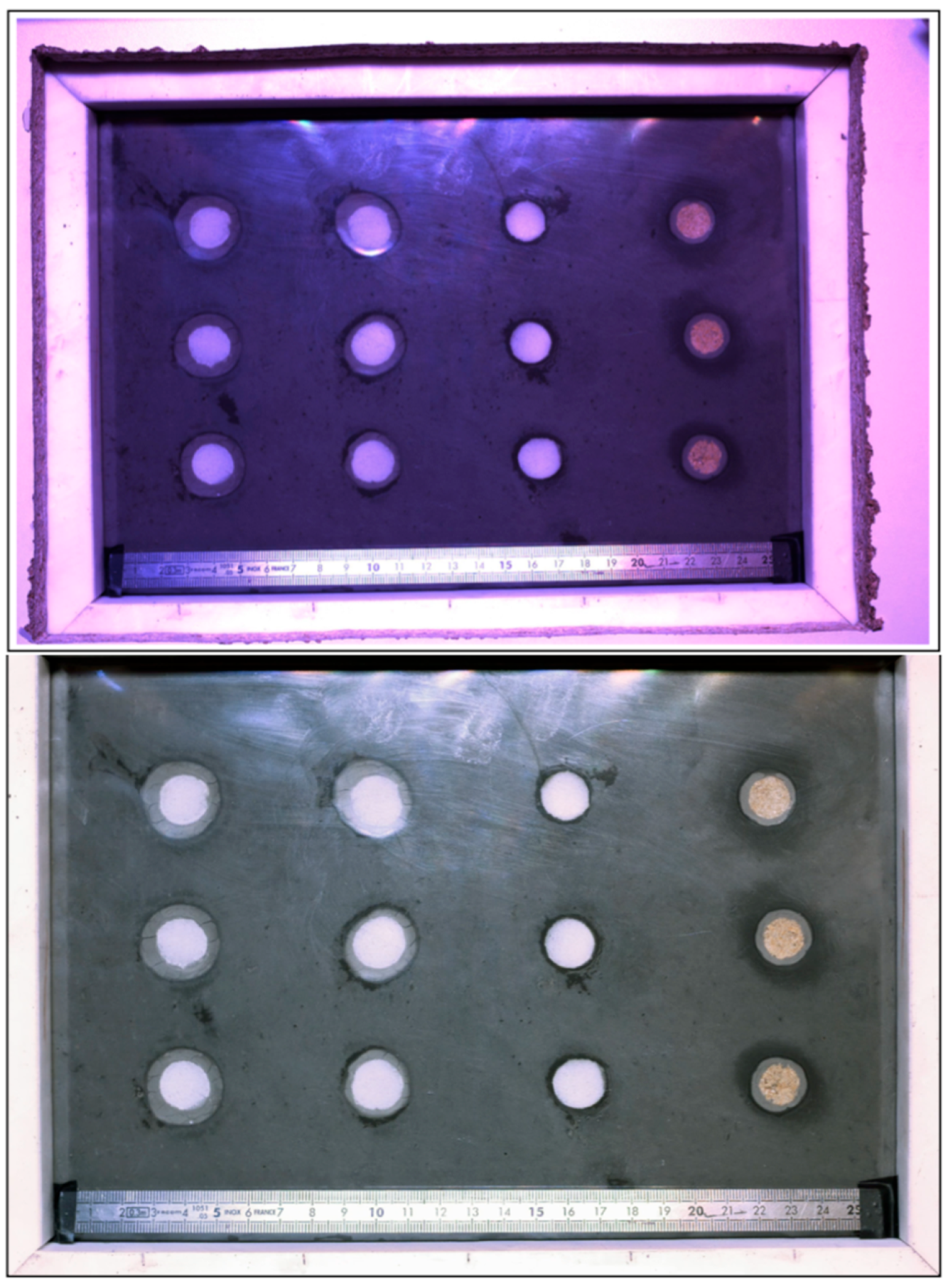

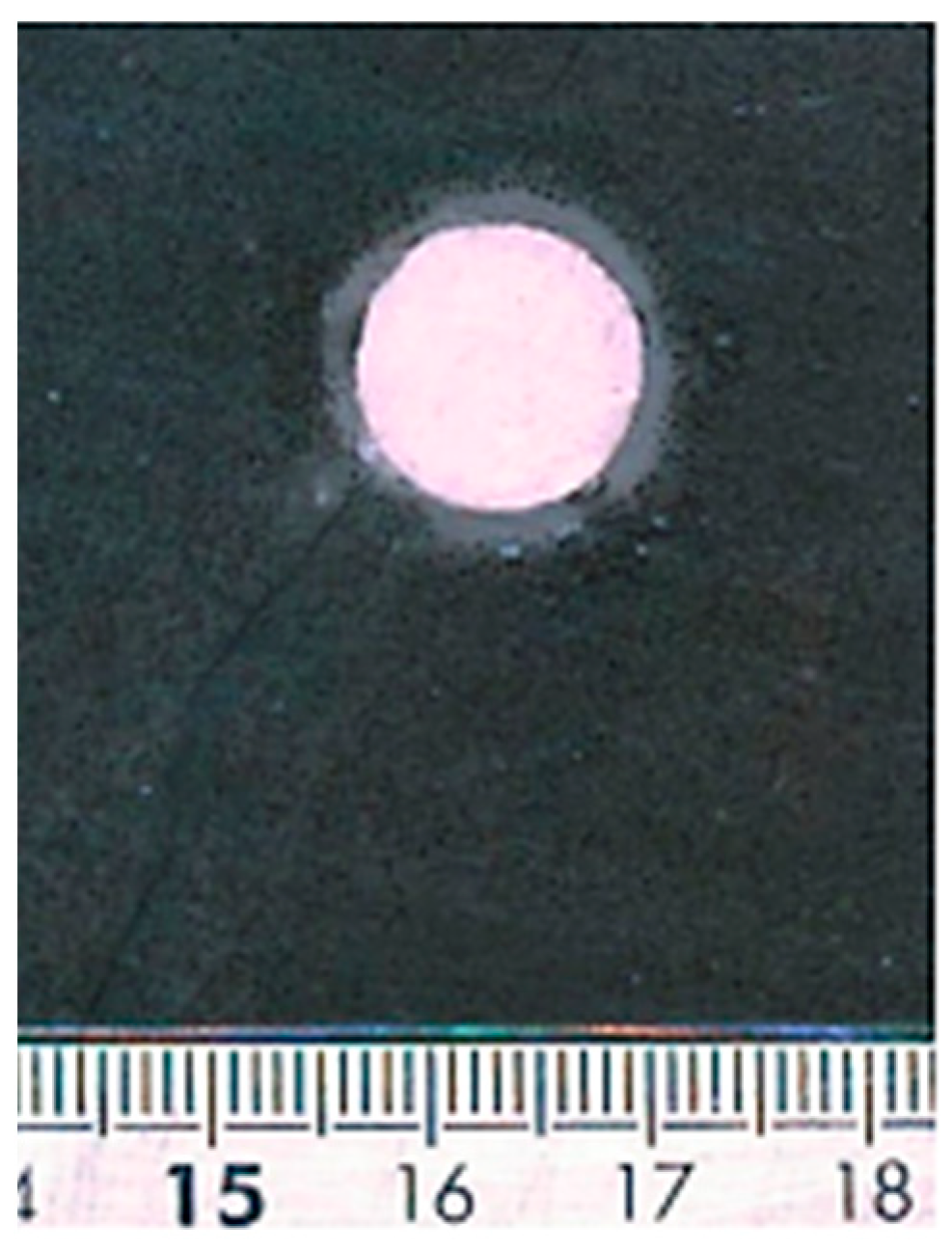


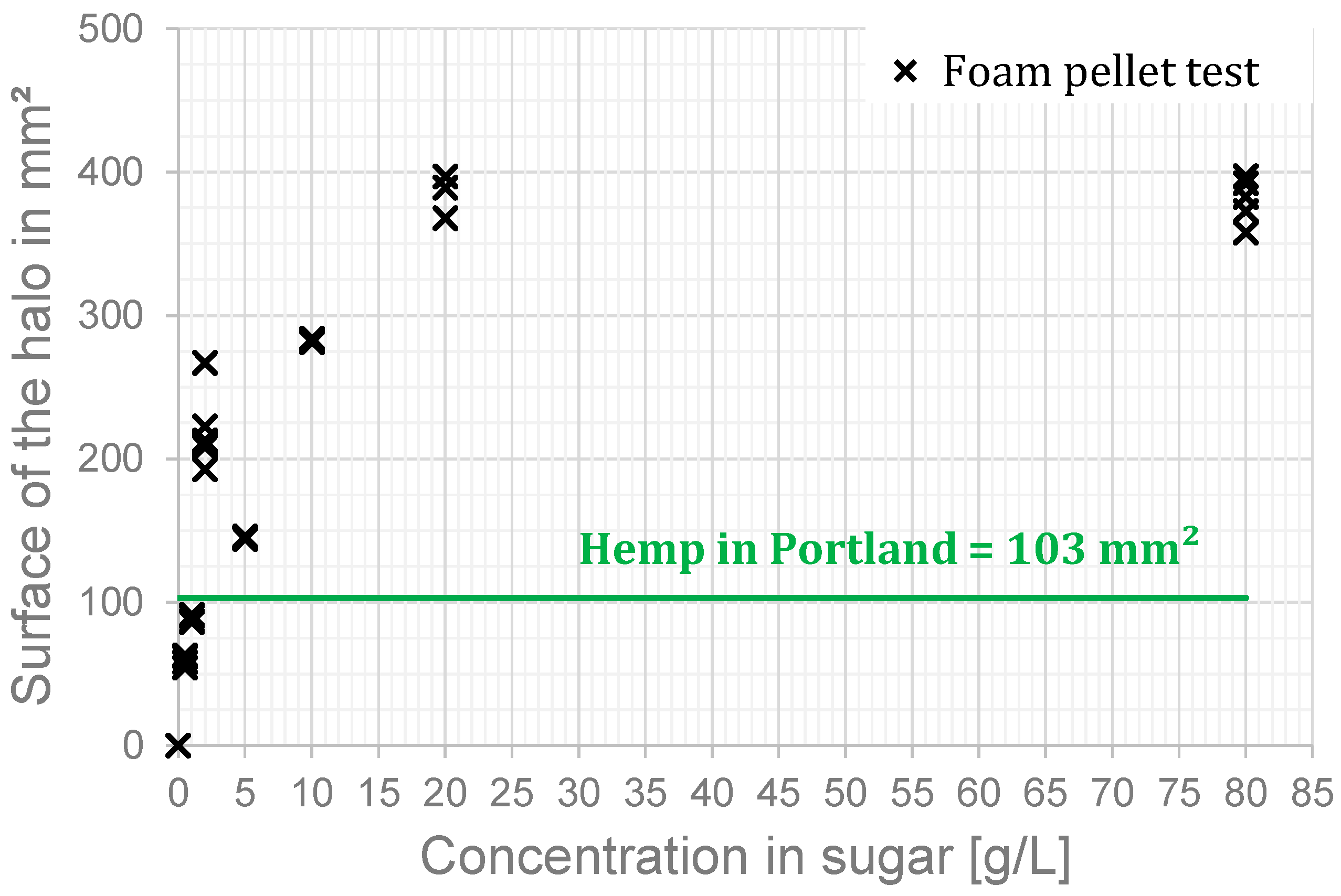

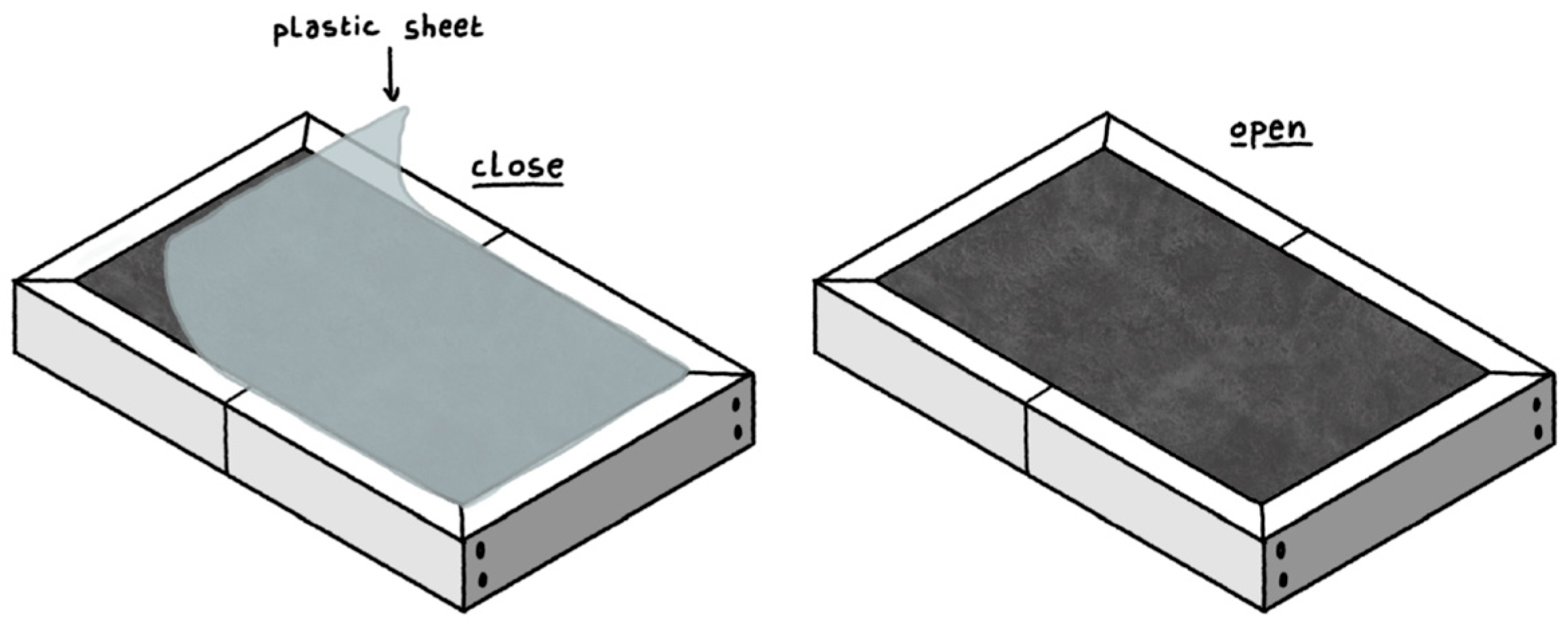
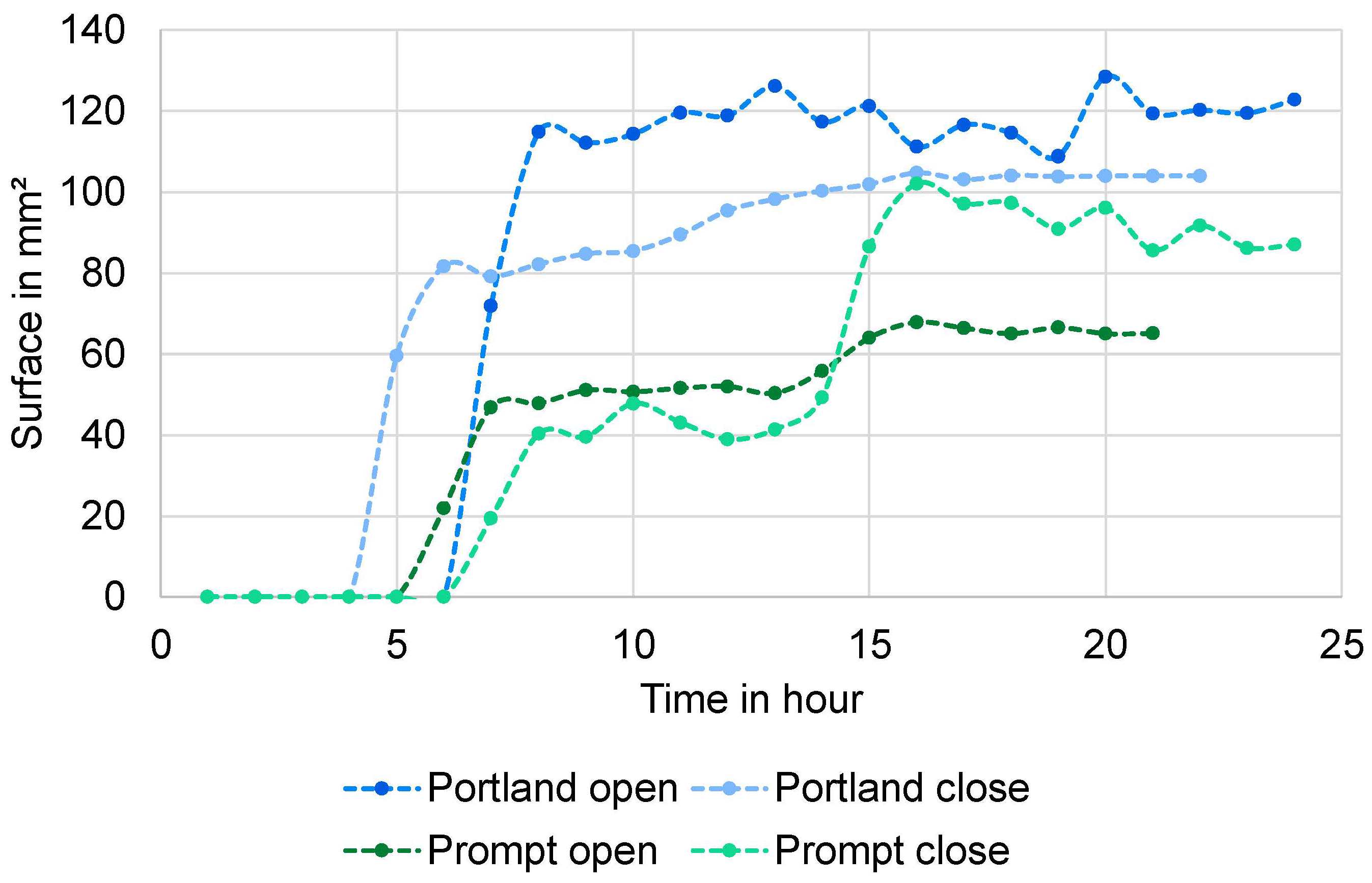
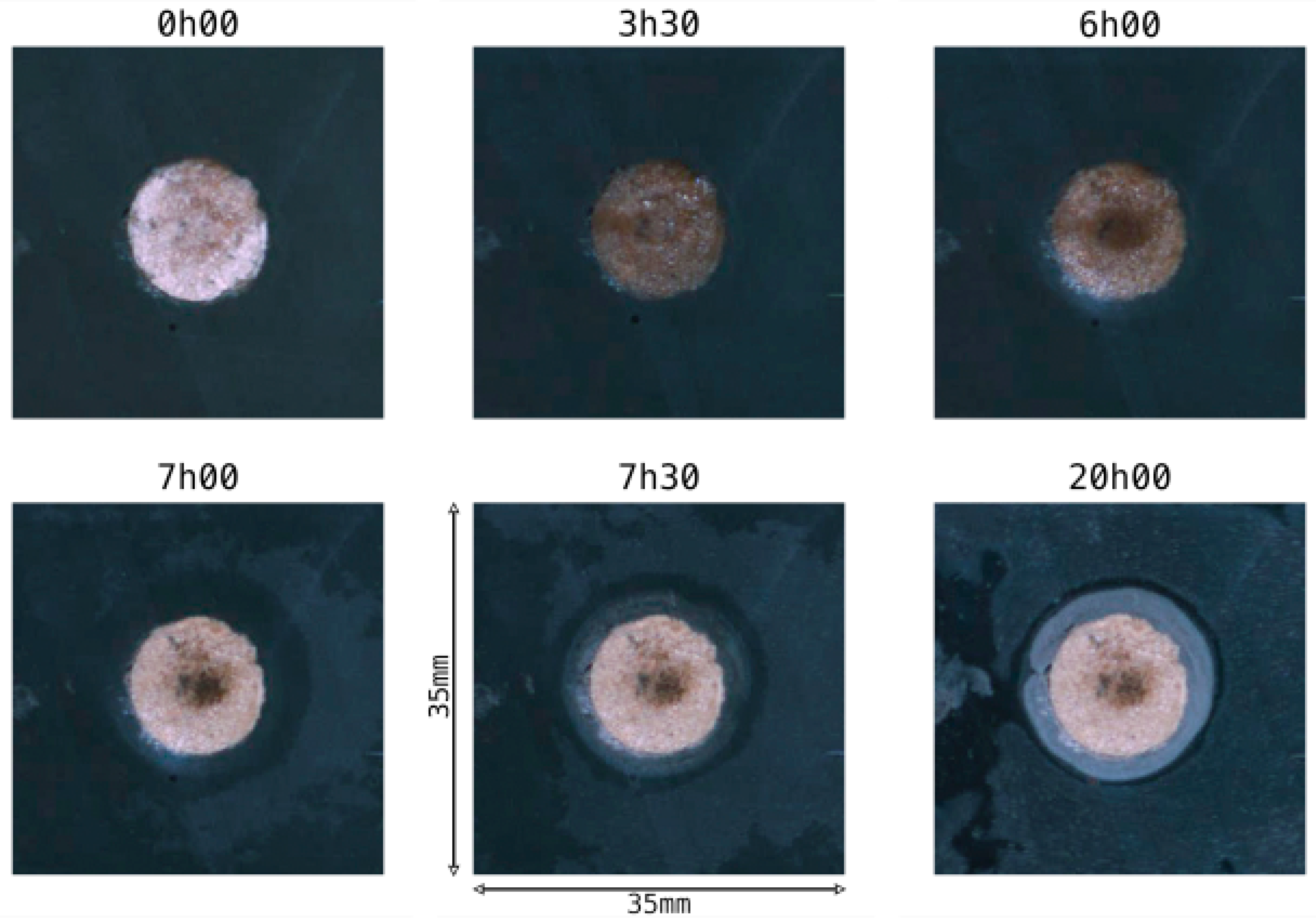
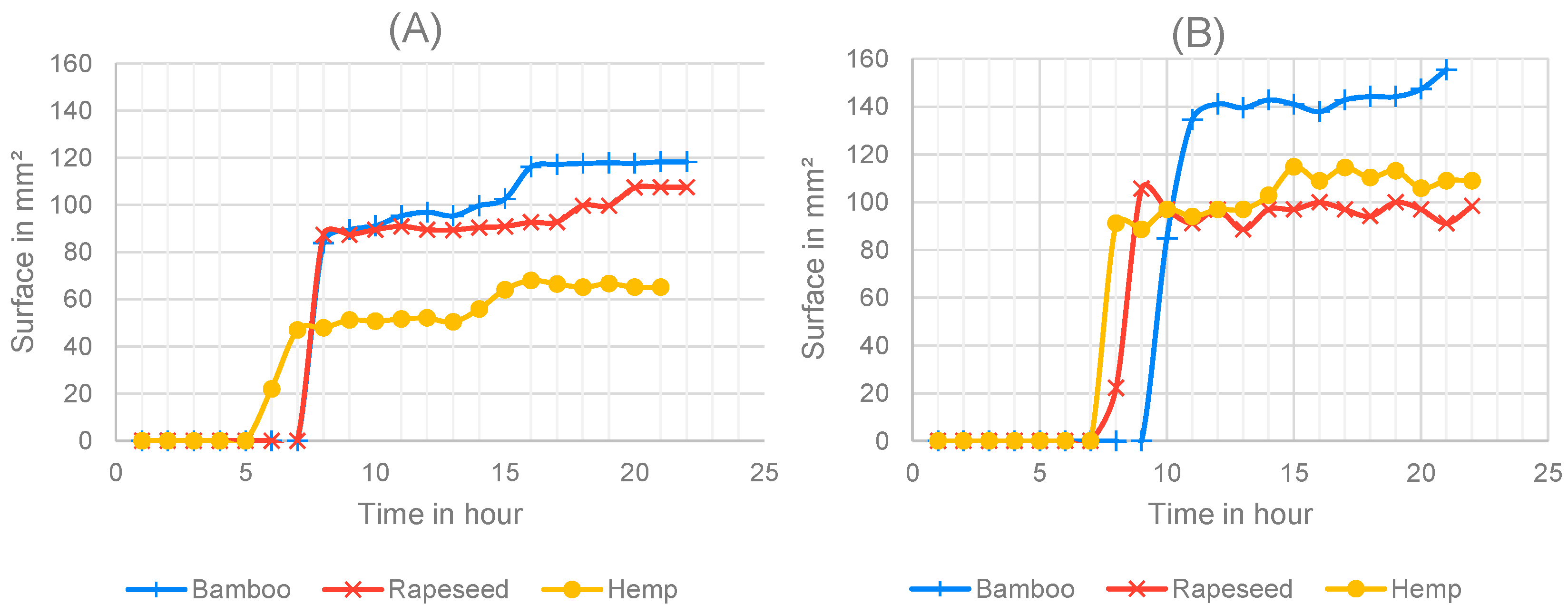
| Hemp | Bamboo | Rapeseed | |
|---|---|---|---|
| H D50 [mm] | 4.7 | 5.0 | 6.8 |
| L D50 [mm] | 2.8 | 3.1 | 3.7 |
| Dust content (%) | 1.4 | 11.5 | 11.6 |
| Initial rate of absorption (%) | 226 | 38 | 268 |
| Bulk density before drying, ρwet [kg/m3] | 110 | 305 | 100 |
| Bulk density after drying, ρdry [kg/m3] | 110 | 304 | 89 |
Disclaimer/Publisher’s Note: The statements, opinions and data contained in all publications are solely those of the individual author(s) and contributor(s) and not of MDPI and/or the editor(s). MDPI and/or the editor(s) disclaim responsibility for any injury to people or property resulting from any ideas, methods, instructions or products referred to in the content. |
© 2024 by the authors. Licensee MDPI, Basel, Switzerland. This article is an open access article distributed under the terms and conditions of the Creative Commons Attribution (CC BY) license (https://creativecommons.org/licenses/by/4.0/).
Share and Cite
Prud’Homme, E.; Delhomme, F.; Julliot, C.; Corvalan, L.; Amziane, S.; Toussaint, E.; Marceau, S. A New Experimental Setup to Characterize Binder–Vegetal Particle Compatibility in Plant-Based Concrete. Buildings 2024, 14, 1000. https://doi.org/10.3390/buildings14041000
Prud’Homme E, Delhomme F, Julliot C, Corvalan L, Amziane S, Toussaint E, Marceau S. A New Experimental Setup to Characterize Binder–Vegetal Particle Compatibility in Plant-Based Concrete. Buildings. 2024; 14(4):1000. https://doi.org/10.3390/buildings14041000
Chicago/Turabian StylePrud’Homme, Elodie, Fabien Delhomme, Clara Julliot, Loïc Corvalan, Sofiane Amziane, Evelyne Toussaint, and Sandrine Marceau. 2024. "A New Experimental Setup to Characterize Binder–Vegetal Particle Compatibility in Plant-Based Concrete" Buildings 14, no. 4: 1000. https://doi.org/10.3390/buildings14041000
APA StylePrud’Homme, E., Delhomme, F., Julliot, C., Corvalan, L., Amziane, S., Toussaint, E., & Marceau, S. (2024). A New Experimental Setup to Characterize Binder–Vegetal Particle Compatibility in Plant-Based Concrete. Buildings, 14(4), 1000. https://doi.org/10.3390/buildings14041000







